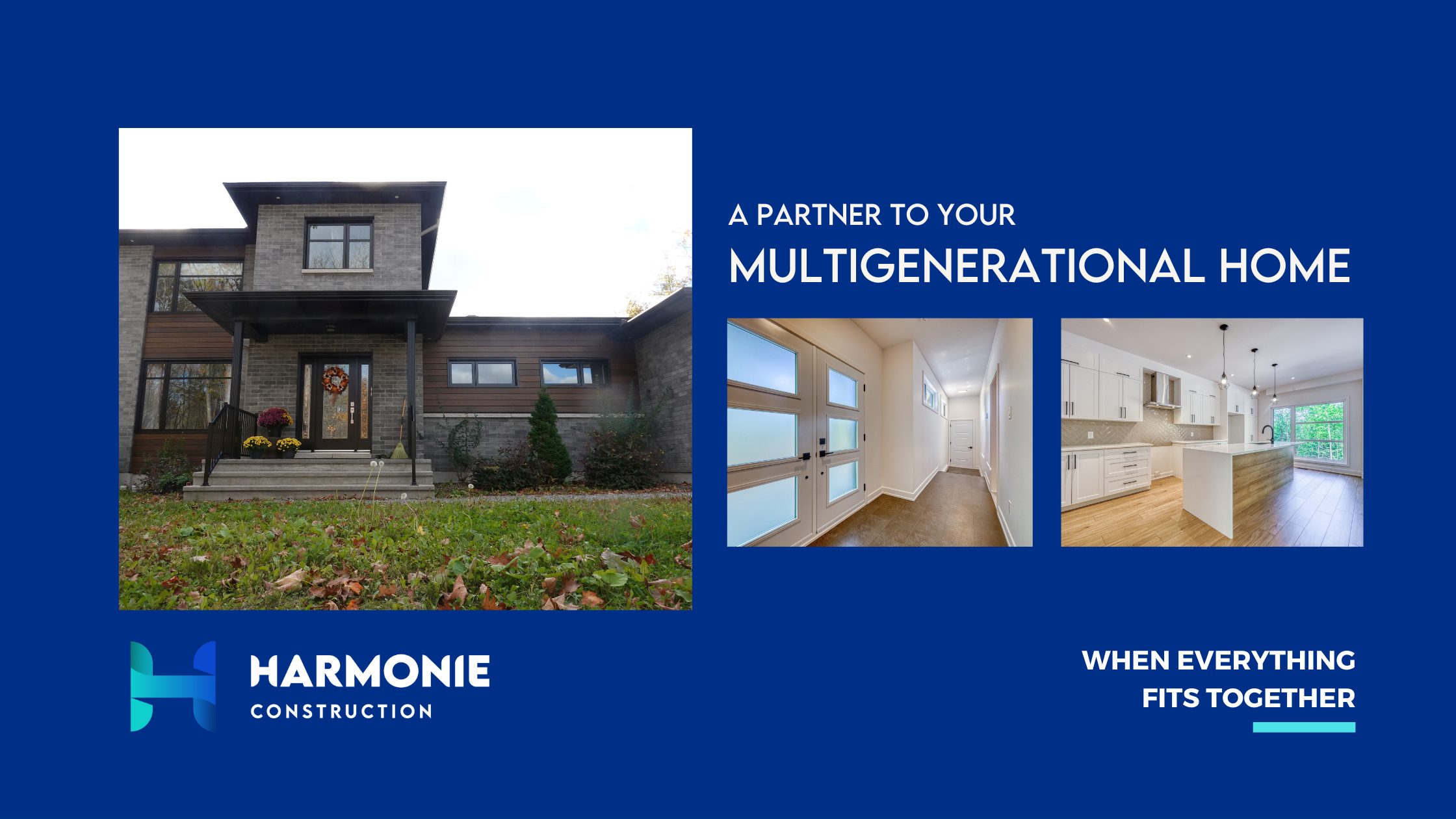A Multi-Generational Homes Revolution for 2024

In 2023, the increasing demand for multi-generational homes reflects a clever response to the evolving needs of modern families. The resurgence of the intergenerational model illustrates a notable trend, emphasizing these residences’ financial and tax benefits. They also highlight an environment conducive to mutual support, strengthening family bonds, and preserving intimacy.
Maxime Thérien, our President at Harmonie Construction, expresses, “We are already witnessing a growing interest in multi-generational homes for 2024. They are reshaping our way of cohabiting, transcending generations. It’s a beautiful evolution in the world of housing! We are currently investing in innovative spaces and models to incorporate this option into our development projects.”
Let’s delve into the details of this evolution, which promises to be a genuine real estate revolution.
A Unique Balance between Intimacy and Family Solidarity
The multi-generational home, beyond playing a vital role in strengthening family bonds, also ensures the preservation of the intimate spheres of each family member. The opportunity for grandparents to have their own space creates a delicate balance between proximity and autonomy, fostering family relationships.
In this distinctive family context, the presence of grandparents becomes a major asset for the quality of shared moments. Closed doors do not mean solitude but rather preserved intimacy, creating a balance between communal living and respecting individual needs.
The multi-generational home thus becomes the stage for harmonious cooperation, where each member provides a unique contribution. Grandparents can offer their experience and time, while parents benefit from practical support, enabling them to thrive professionally. Of course, it is the grandchildren who emerge as the primary beneficiaries!
Multi-Generational Homes, a Synonym for Intimacy and Proximity
One of the distinctive features of multi-generational homes is the preservation of the privacy of each unit. With separate entrances, independent balconies, and private living spaces such as kitchens and bathrooms, these homes offer proximity while mitigating potential isolation. Each generation benefits from a well-defined space, creating a balance between communal living and individual privacy. We invite you to read our article on the importance of design available on our website. It provides insightful perspectives on how design can transform not only the aesthetics but also the functionality of new constructions.
Possibilities and Adaptability
The variety of multi-generational home typologies caters to diverse family needs. Whether it’s two individual residences on a single lot, two connected houses, or a single house with two distinct dwellings, the multi-generational home adapts to different configurations.
Some multi-generational home configurations have separate addresses. In this context, each unit maintains financial autonomy by managing its expenses, such as electricity and cable. Additionally, each unit can have its own mailbox, reinforcing the individuality of the two households. This approach promotes the independence of each residential entity, providing a more personalized solution to the specific needs of each its occupants.
Multiple Savings and Easy Adaptation
Beyond the familial aspect, multi-generational homes contribute to a multitude of savings. From mortgages costs to household expenses, to the the high costs of living in retirement residences, these homes offer a wide range of economic benefits. Sharing expensive amenities, such as the pool, landscaping tools, snow removal equipment, and outdoor cooking facilities, provides an additional financial advantage. What if we took advantage of this to set up a multifunctional laundry room for common use?
Alternative to the Needs of Seniors in an Aging Society
Multi-generational homes prove to be a solution allowing seniors to stay close to their families and eliminating the need to move to specialized facilities. This intergenerational proximity becomes a crucial element in addressing the evolving needs of our aging society.
This concept also has significant benefits for family caregivers, by making seniors more accessible and reducing associated stress. Knowing that seniors are right next door facilitates care planning and offers increased peace of mind, promoting a more peaceful night’s sleep.
Moreover, multi-generational homes offer the opportunity to plan for early adaptations to extend seniors’ independent living. For example, accessible design can include integrated mobility aids and barrier-free showers, anticipating future needs and creating an environment conducive to well-being and autonomy.
Considering that the population is aging faster than the construction of housing for seniors is progressing, and such housing is scarce outside major cities, multi-generational homes emerge as a promising alternative. They present a solution for seniors to stay close to their families, eliminating the need to move to adapted residences. This intergenerational proximity becomes an essential element in addressing the changing needs of our aging society.
Multi-Generational Homes, Beyond Traditional Family Structures
Multi-generational homes exhibit a versatility that goes beyond conventional family needs. They also adapt seamlessly to other family scenarios and less traditional living arrangements, as presented in our article “Strategies to Access Property in 2024”.
For example, multi-generational homes offer a practical solution for families with children transitioning to adulthood, whether during their university studies or when considering purchasing their own home. This flexibility allows for continuity in family support while respecting the increasing independence of young adults.
Furthermore, these residences can also respond to less conventional family arrangements, such as friends deciding to live together, individual partnerships, or situations where tenants share the space. The adaptable design of multi-generational homes can adjust to a variety of needs and family dynamics, providing an inclusive and versatile residential solution for a diversity of lifestyles.
Harmonie Construction : Redefining Multi-generational Homes
Multi-generational homes not only meet the needs of modern families but anticipate them. By fostering mutual support, strengthening family bonds, and offering substantial savings, these multifamily houses redefine how we conceive our homes.
Whether countering isolation, simplifying daily life, or creating a balance between communal living and individual intimacy, multi-generational homes emerge as havens where each generation can flourish harmoniously.
Do you want to find out if a mult-igenerational concept could meet your needs? Answer the questionnaire, in just 2 minutes, to discover your mult-igenerational profile!


